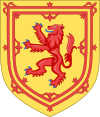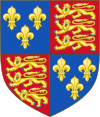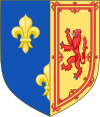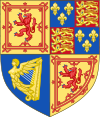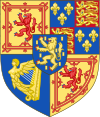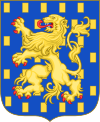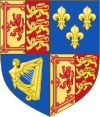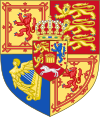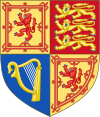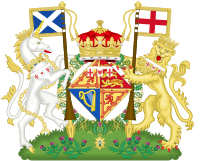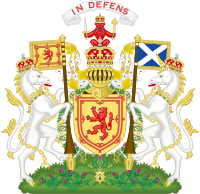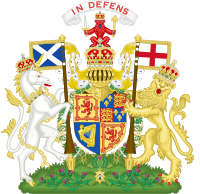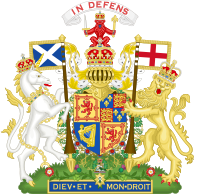User:Endrick Shellycoat/Sandbox
 | |
| Scottish Union Flag | |
| Use | Other |
|---|---|
| Proportion | 3:5 |
| Adopted | 17th c. (Scotland) |
| Design | "Azure, a Cross gules, fimbriated, argent; over all a Saltier of the last" |
Historical evidence suggests that the Scottish Union Flag was used unofficially in the Kingdom of Scotland during the 17th C. and existed, at least within documents and some sections of popular culture, in post-Union Scotland until at least the middle of the 19th C. This variant was the product of a popular negative reaction within sections of Scottish society towards that design of Union flag adopted by English Heralds in 1606, following the Union of the Crowns; James VI, King of Scots, having acceded to the thrones of England and Ireland as King James I in 1603.
Design[edit]
The flag's blazon is described as "Azure, a Cross gules, fimbriated, argent; over all a Saltier of the last", or alternatively as "On a blue shield (field?) of Scotland the red cross of St. George fimbriated with its white field, surmounted by the white cross of St. Andrew".[1]
This design results in the white saltire of St. Andrew passing in front of rather than behind the cross of St. George, thus giving precidence to the Scottish element; their being held a belief by those who conceived this design that both the Scottish kingdom and saltire were older than their English counterparts.
History[edit]

In 1603, King James I & VI united the crowns of England and Ireland together with Scotland in a personal union; each kingdom remaining a separate state albeit sharing a single monarch.[2] On 12 April 1606, a new flag to represent this regal union between England and Scotland was specified in a royal decree, according to which the flag of England (a red cross on a white background, known as St. George's Cross), and the flag of Scotland (a white saltire on a blue background, known as the Saltire or St. Andrew's Cross), would be joined together[3], forming the flag of Great Britain and first union flag:
| “ | By the King: Whereas, some differences hath arisen between Our subjects of South and North Britaine travelling by Seas, about the bearing of their Flagges: For the avoiding of all contentions hereafter. We have, with the advice of our Council, ordered: That from henceforth all our Subjects of this Isle and Kingdome of Great Britaine, and all our members thereof, shall beare in their main-toppe the Red Crosse, commonly called St. George’s Crosse, and the White Crosse, commonly called St. Andrew’s Crosse, joyned together according to the forme made by our heralds, and sent by Us to our Admerall to be published to our Subjects: and in their fore-toppe our Subjects of South Britaine shall weare the Red Crosse onely as they were wont, and our Subjects of North Britaine in their fore-toppe the White Crosse onely as they were accustomed. – 1606. | ” |
| — Proclamation of James I of England, King of Scots: Orders in Council; Official creation of the Union Flag – 1606.[4] | ||
In objecting strongly to the form and pattern of union flag adopted by James' heralds whereby the cross of St. George surmounted that of St. Andrew, a great number of shipmasters and ship-owners in Scotland took up the matter with John Erskine, 18th Earl of Mar, and were encouraged by him to send a letter of complaint, dated 7 August 1606, to James VI, via the Privy Council of Scotland, stating:
| “ | Most sacred Soverayne. A greate nomber of the maisteris and awnaris of the schippis of this your Majesteis kingdome hes verie havelie compleint to your Majesteis Counsell that the form and patrone of the flaggis of schippis, send doun heir and commandit to be ressavit and used be the subjectis of boith kingdomes, is very prejudiciall to the fredome and dignitie of this Estate and will gif occasioun of reprotche to this natioun quhairevir the said flage sal happin to be worne beyond sea becaus, as your sacred majestie may persave, the Scottis Croce, callit Sanctandrois Croce is twyse divydit, and the Inglishe Croce, callit Sanct George, haldin haill and drawne through the Scottis Croce, whiche is thairby obscurit and no takin nor merk to be seen of the Scottis Armes. This will breid some heit and miscontentment betwix your Majesteis subjectis, and it is to be ferit that soem inconvenientis sall fall out betwix thame, for oure seyfairing men cannot be inducit to ressave that flag as it is set doun. They haif drawne two new drauchtis and patronis as most indifferent for boith kingdomes which they present to the Counsell, and craved our approbatioun of the same; bot we haif reserved that to you Majesteis princelie determination, | ” |
| — Letter of complaint to James VI[5] | ||
Although those documents accompanying this letter which contained the two new draught patterns were lost in a fire, and no trace remains of any response made by King James to the complaint itself, evidence of an unofficial Scottish variant, whereby the Scottish cross was uppermost, does exist.[6][7] An early account of the possible use of such a flag refers to an occasion in 1617 where in welcoming James VI to Dumfries, the Town Commissar was reported to have stated "Your Royall Majestie, in whose sacred person the King of kings hath miraculouslie united so many glorious Kingdoms, under whose Scepter the whyte and reid crocies are so proportionablie interlaced".[8] This description of the crosses being "so proportionablie interlaced" is interpreted by some as evidence of a Scottish version of the union flag,[9] however others dispute this interpretation.
The Saltire is one of the key components of the Union Flag[10] which, since its creation in 1606, has appeared in various forms[11] following the Flag of Scotland and Flag of England first being merged to mark the Union of the Crowns.[12] (The Union of the Crowns having occurred three years earlier, in 1603, when James VI, King of Scots, acceded to the thrones of both England and Ireland upon the death of Elizabeth I of England). The proclamation by King James, made on the 12 April 1606, which led to the creation of the Union Flag states:
In objecting to the design of Union Flag in 1606, whereby the cross of Saint George surmounted that of Saint Andrew, a group of Scots took up the matter with John Erskine, 18th Earl of Mar, and were encouraged by him to send a letter of complaint to James VI, via the Privy Council of Scotland, which stated that the flag's design "will breid some heit and miscontentment betwix your Majesties subjectis, and it is to be feirit that some inconvenientis sail fall oute betwix thame, for our seyfaring men cannot be inducit to resave that flage as it is set down".[13] Although documents accompanying this complaint which contained draughts for alternative designs have been lost, evidence of an unofficial Scottish variant, whereby the Scottish cross was uppermost, does exist.[14][15] An early account of the possible use of such a flag refers to an occasion in 1617 where in welcoming James VI to Dumfries, the Town Commissar was reported to have stated "Your Royall Majestie, in whose sacred person the King of kings hath miraculouslie united so many glorious Kingdoms, under whose Scepter the whyte and reid crocies are so proportionablie interlaced".[16] This description of the crosses being "so proportionablie interlaced" is interpreted by some as evidence of a Scottish version of the union flag,[17] however others dispute this interpretation.
Evidence to suggest actual use of this flag appears in the depiction of Edinburgh Castle by John Slezer, in his series of engravings entitled Theatrum Scotiae, c. 1693. Appearing in later editions of Theatrum Scotiae, this engraving depicts the Scotch (to use the appropriate adjective of that period) version of the Union Flag flying from the Castle Clock Tower.[18] Furthermore, this flag's design is described in the 1704 edition of The Present State of the Universe by John Beaumont, Junior, which contains as an appendix The Ensigns, Colours or Flags of the Ships at Sea: Belonging to The several Princes and States in the World. Within this appendix, the flag's blazon is given as "Azure, a Cross gules, fimbriated, argent; over all a Saltier of the last".[19] This blazon is described elsewhere as "On a blue shield (field?) of Scotland the red cross of St. George fimbriated with its white field, surmounted by the white cross of St. Andrew".[20]
On 17 April 1707, just two weeks prior to the Acts of Union coming into effect, and with Sir Henry St George, Garter King of Arms, having presented seven designs of flag to Queen Anne and her Privy Council for consideration, the flag for the soon to be unified Kingdom of Great Britain was chosen. Along with that version finally selected, the designs for consideration had included that version of Union Flag showing the Cross of Saint Andrew uppermost; identified as being the "Scotts union flagg as said to be used by the Scotts".[21] Despite bold lobbying on the part of the Scots representatives to the Privy Council, all their efforts were to be in vain, for that version of Union Flag showing the Cross of Saint George uppermost was destined to win the day.[22]
In 2006, despite almost three centuries having passed since last being used, Scottish historian David R. Ross called for Scotland to once again adopt this design, in order to "reflect separate national identities across the UK".[23] Despite an apparent lack of widespread public support in Scotland for such a proposal, the Scottish Union Flag may yet continue to find favour in some quarters. For example, to mark the 2009 Open Day celebrations on May 31 at Lennoxlove House, the historic seat of the Dukes of Hamilton, the Scottish Union Flag was observed flying from the flag pole on Lennoxlove House itself.[24]
Other proposed versions[edit]



Various other designs for a common flag were drawn up following the union of the two Crowns in 1603, but were rarely, if ever, used.[26] One version showed St George's cross with St Andrew's cross in the canton, and another version placed the two crosses side by side.
Scottish Union Flag[edit]
In objecting to the design of Union Flag adopted in 1606, whereby the cross of Saint George surmounted that of Saint Andrew, a group of Scots took up the matter with John Erskine, 18th Earl of Mar, and were encouraged by him to send a letter of complaint to James VI, via the Privy Council of Scotland, which stated that the flag's design "will breid some heit and miscontentment betwix your Majesties subjectis, and it is to be feirit that some inconvenientis sail fall oute betwix thame, for our seyfaring men cannot be inducit to resave that flage as it is set down".[27] Although documents accompanying this complaint which contained draughts for alternative designs have been lost, evidence of an unofficial Scottish variant, whereby the Scottish cross was uppermost, does exist.[28][29] An early account of the possible use of such a flag, whereby the Scottish cross has the place of honour,[30] refers to an occasion in 1617 where in welcoming James VI to Dumfries, the Town Commissar was reported to have stated "Your Royall Majestie, in whose sacred person the King of kings hath miraculouslie united so many glorious Kingdoms, under whose Scepter the whyte and reid crocies are so proportionablie interlaced".[31] However, the mere mentioned of St. Andrew's cross first does not support such a conclusion.[32]
Evidence to suggest actual use of this flag appears in the depiction of Edinburgh Castle by John Slezer, in his series of engravings entitled Theatrum Scotiae, c. 1693. Appearing in later editions of Theatrum Scotiae, this engraving depicts the Scotch (to use the appropriate adjective of that period) version of the Union Flag flying from the Castle Clock Tower.[33] Furthermore, this flag's design is described in the 1704 edition of The Present State of the Universe by John Beaumont, Junior, which contains as an appendix The Ensigns, Colours or Flags of the Ships at Sea: Belonging to The several Princes and States in the World. [34] This flag's blazon is described elsewhere as "Azure, a Cross gules, fimbriated, argent; over all a Saltier of the last", or alternatively as "On a blue shield (field?) of Scotland the red cross of St. George fimbriated with its white field, surmounted by the white cross of St. Andrew".[35]
On 17 April 1707, just two weeks prior to the Acts of Union coming into effect, and with Sir Henry St George, Garter King of Arms, having presented several designs of flag to Queen Anne and her Privy Council for consideration, the flag for the soon to be unified Kingdom of Great Britain was chosen. At the suggestion of the Scots representatives, the designs for consideration included that version of Union Flag showing the Cross of Saint Andrew uppermost; identified as being the "Scotts union flagg as said to be used by the Scotts".[36] However, the Queen and her Council approved Sir Henry's original effort, numbered "one".[36]
Scottish Union Flag[edit]

The Saltire is one of the key components of the Union Flag[37] which, since its creation in 1606, has appeared in various forms[38] following the Flag of Scotland and Flag of England first being merged to mark the Union of the Crowns.[39] (The Union of the Crowns having occurred three years earlier, in 1603, when James VI, King of Scots, acceded to the thrones of both England and Ireland upon the death of Elizabeth I of England). The proclamation by King James, made on the 12 April 1606, which led to the creation of the Union Flag states:
| “ | By the King: Whereas, some differences hath arisen between Our subjects of South and North Britaine travelling by Seas, about the bearing of their Flagges: For the avoiding of all contentions hereafter. We have, with the advice of our Council, ordered: That from henceforth all our Subjects of this Isle and Kingdome of Great Britaine, and all our members thereof, shall beare in their main-toppe the Red Crosse, commonly called St. George’s Crosse, and the White Crosse, commonly called St. Andrew’s Crosse, joyned together according to the forme made by our heralds, and sent by Us to our Admerall to be published to our Subjects: and in their fore-toppe our Subjects of South Britaine shall weare the Red Crosse onely as they were wont, and our Subjects of North Britaine in their fore-toppe the White Crosse onely as they were accustomed. – 1606. | ” |
| — Proclamation of James I of England, King of Scots: Orders in Council; Official creation of the Union Flag – 1606.[40] | ||
In objecting strongly to the form and pattern of Union Flag adopted by James' heralds whereby the cross of Saint George surmounted that of Saint Andrew, (regarded in Scotland as a slight upon the Scottish nation), a great number of shipmasters and ship-owners in Scotland took up the matter with John Erskine, 18th Earl of Mar, and were encouraged by him to send a letter of complaint, dated 7 August 1606, to James VI, via the Privy Council of Scotland, stating:
| “ | Most sacred Soverayne. A greate nomber of the maisteris and awnaris of the schippis of this your Majesteis kingdome hes verie havelie compleint to your Majesteis Counsell that the form and patrone of the flaggis of schippis, send doun heir and commandit to be ressavit and used be the subjectis of boith kingdomes, is very prejudiciall to the fredome and dignitie of this Estate and will gif occasioun of reprotche to this natioun quhairevir the said flage sal happin to be worne beyond sea becaus, as your sacred majestie may persave, the Scottis Croce, callit Sanctandrois Croce is twyse divydit, and the Inglishe Croce, callit Sanct George, haldin haill and drawne through the Scottis Croce, whiche is thairby obscurit and no takin nor merk to be seen of the Scottis Armes. This will breid some heit and miscontentment betwix your Majesteis subjectis, and it is to be ferit that soem inconvenientis sall fall out betwix thame, for oure seyfairing men cannot be inducit to ressave that flag as it is set doun. They haif drawne two new drauchtis and patronis as most indifferent for boith kingdomes which they present to the Counsell, and craved our approbatioun of the same; bot we haif reserved that to you Majesteis princelie determination, | ” |
| — Letter of complaint to James VI[41] | ||
Although those documents accompanying this letter which contained the two new draught patterns were lost in a fire, and no trace remains of any response made by King James to the complaint itself, evidence of an unofficial Scottish variant, whereby the Scottish cross was uppermost, does exist.[42][43] An early account of the possible use of such a flag refers to an occasion in 1617 where in welcoming James VI to Dumfries, the Town Commissar was reported to have stated "Your Royall Majestie, in whose sacred person the King of kings hath miraculouslie united so many glorious Kingdoms, under whose Scepter the whyte and reid crocies are so proportionablie interlaced".[44] This description of the crosses being "so proportionablie interlaced" is interpreted by some as evidence of a Scottish version of the union flag,[45] however others dispute this interpretation.
Evidence to suggest actual use of this flag appears in the depiction of Edinburgh Castle by John Slezer, in his series of engravings entitled Theatrum Scotiae, c. 1693. Appearing in later editions of Theatrum Scotiae, this engraving depicts the Scotch (to use the appropriate adjective of that period) version of the Union Flag flying from the Castle Clock Tower.[46] Furthermore, this flag's design is described in the 1704 edition of The Present State of the Universe by John Beaumont, Junior, which contains as an appendix The Ensigns, Colours or Flags of the Ships at Sea: Belonging to The several Princes and States in the World. Within this appendix, the flag's blazon is given as "Azure, a Cross gules, fimbriated, argent; over all a Saltier of the last".[47] This blazon is described elsewhere as "On a blue shield (field?) of Scotland the red cross of St. George fimbriated with its white field, surmounted by the white cross of St. Andrew".[48]
On 17 April 1707, just two weeks prior to the Acts of Union coming into effect, and with Sir Henry St George, Garter King of Arms, having presented seven designs of flag to Queen Anne and her Privy Council for consideration, the flag for the soon to be unified Kingdom of Great Britain was chosen. Along with that version finally selected, the designs for consideration had included that version of Union Flag showing the Cross of Saint Andrew uppermost; identified as being the "Scotts union flagg as said to be used by the Scotts".[49] Despite bold lobbying on the part of the Scots representatives to the Privy Council, all their efforts were to be in vain, for that version of Union Flag showing the Cross of Saint George uppermost was destined to win the day.[50]
From 1801, in order to symbolise the union of the Kingdom of Great Britain with the Kingdom of Ireland a new design, which included the St Patrick's Cross, was adopted for the flag of the United Kingdom of Great Britain and Ireland.[51] The Flag of the United Kingdom, having remained unchanged following the partition of Ireland in 1921 and creation of the Irish Free State and Northern Ireland, continues to be used as the flag of the United Kingdom of Great Britain and Northern Ireland.
-
Scottish Union Flag. An unofficial Scottish variant of the 1606 Union Flag used in the Kingdom of Scotland from the early 17th c. until 1707, following the Union of the Crowns in 1603.
-
The Union Flag used in the Kingdom of England from 1606 and, following the Acts of Union between Scotland and England, the flag of the Kingdom of Great Britain from 1707-1800.
-
Union Flag used since 1801, incorporating the Cross of Saint Patrick, following the Act of Union between the Kingdom of Great Britain and the Kingdom of Ireland. (3:5 variant shown)
References[edit]
- ^ Various contributors (1882). The Reliquary v. 22. John Russell Smith.
{{cite book}}:|last=has generic name (help) Google books - ^ Cite error: The named reference
Flagsofworldwas invoked but never defined (see the help page). - ^ Cite error: The named reference
flaginstwas invoked but never defined (see the help page). - ^ Fox-Davies, Arthur Charles (1904 [1986]). The Art of Heraldry: An Encyclopaedia of Armory. London: Bloomsbury Books. p. 399. ISBN 0906223342.
{{cite book}}: Check date values in:|year=(help) - ^ Perrin, William G (1922). British Flags; Their Early History and their Development at Sea, with an Account of the Origin of the Flag as a National Device. Oxford University Press. p. 207. Google Books
- ^ William McMillan and John Alexander Stewart (1925). The story of the Scottish flag. H. Hopkins. p. 112. Google books: "This flag had official recognition"
- ^ Bartram, Graham (2005). British Flags & Emblems. Flag Institute/Tuckwell. p. 122. Google books: "Unofficial 1606 Scottish Union Flag"
- ^ Nichols, John (1828). The progresses, processions, and magnificent festivities, of King James the First: his royal consort, family, and court; collected from original manuscripts, scarce pamphlets, corporation records, parochial registers, &c., &c. ... Illustrated with notes, historical, topographical, biographical ... J. B. Nichols. Google books
- ^ Paul Harris, William McMillan and John Stewart (1992). Story of Scotland's Flag. Lang Syne Publishers. p. 48.
- ^ "Saint Andrew and his flag". Scots History Online. Retrieved 2009-12-02.
- ^ "Symbols of the Monarchy: Union Jack". Royal Website. Retrieved 2009-12-02.
- ^ Bartram, Graham (2008-10-18). "British flags". The Flag Institute. Retrieved 2009-12-14.
- ^ Hulme, Edward. F. (1897). The flags of the world : their history, blazonry and associations. F. Warne & co. p. 152. Full text at 'The Internet Archive'
- ^ William McMillan and John Alexander Stewart (1925). The story of the Scottish flag. H. Hopkins. p. 112. Google books: "This flag had official recognition"
- ^ Bartram, Graham (2005). British Flags & Emblems. Flag Institute/Tuckwell. p. 122. Google books: "Unofficial 1606 Scottish Union Flag"
- ^ Nichols, John (1828). The progresses, processions, and magnificent festivities, of King James the First: his royal consort, family, and court; collected from original manuscripts, scarce pamphlets, corporation records, parochial registers, &c., &c. ... Illustrated with notes, historical, topographical, biographical ... J. B. Nichols. Google books
- ^ Paul Harris, William McMillan and John Stewart (1992). Story of Scotland's Flag. Lang Syne Publishers. p. 48.
- ^ John Slezer, Robert Sibbald and Abel Swall (1693). Theatrum Scotiae: Containing the prospects of their Majesties castles and palaces: together with those of the most considerable towns and colleges; the ruins of many ancient abbeys, churches, monasteries and convents, within the said kingdom. All curiously engraven on copper plates. With a short ... John Leake. p. 114.
- ^ Beaumont, John (1704 - first published 1701)). The Present State of the Universe: Or an Account of I. The Rise, Births, Names, ... of All the Present Chief Princes of the World. ... Benj. Motte, and are to be sold by John Nutt, 1704. p. 164.
{{cite book}}: Check date values in:|year=(help) - ^ Various contributors (1882). The Reliquary v. 22. John Russell Smith.
{{cite book}}:|last=has generic name (help) Google books - ^ de Burton, Simon (1999-11-09). "How Scots lost battle of the standard". The Scotsman. Johnston Press plc. Retrieved 2009-06-30.
{{cite news}}: Cite has empty unknown parameter:|coauthors=(help)Partial view at Encyclopedia.com - ^ Sears, Neil (1999-12-07). "Byline: Now the father of the Union Jack flies into battle". The Daily Mail. Associated Newspapers Ltd. Retrieved 2008-12-15.
{{cite news}}: Cite has empty unknown parameter:|coauthors=(help)Full view at bnet Business Library: Newspaper Collection - ^ "Let's have a Scottish version of Union flag, says historian" The Scotsman 21 June 2006. Retrieved on 2009-05-05.
- ^ Close up image at flickr.com Retrieved on 2009-07-21 Additional images at Haddington Pipe Band website Retrieved on 2009-07-22
- ^ National Library of Scotland, Slezer's Scotland. Accessed 04 July 2010
- ^ The Kings and Queens of England and Scotland by Plantagenet Somerset Fry (Grove Press, 1990). Includes several proposed versions of the original Union Flag.
- ^ Hulme, Edward. F. (1897). The flags of the world : their history, blazonry and associations. F. Warne & co. p. 152. Full text at 'The Internet Archive'
- ^ William McMillan and John Alexander Stewart (1925). The story of the Scottish flag. H. Hopkins. p. 112. Google books: "This flag had official recognition"
- ^ Bartram, Graham (2005). British Flags & Emblems. Flag Institute/Tuckwell. p. 122. Google books: "Unofficial 1606 Scottish Union Flag"
- ^ Paul Harris, William McMillan and John Stewart (1992). Story of Scotland's Flag. Lang Syne Publishers. p. 48.
- ^ Nichols, John (1828). The progresses, processions, and magnificent festivities, of King James the First: his royal consort, family, and court; collected from original manuscripts, scarce pamphlets, corporation records, parochial registers, &c., &c. ... Illustrated with notes, historical, topographical, biographical ... J. B. Nichols. Google books
- ^ Smith, Whitney (1973). The Flag Bulletin. Flag Research Center.
- ^ John Slezer, Robert Sibbald and Abel Swall (1693). Theatrum Scotiae: Containing the prospects of their Majesties castles and palaces: together with those of the most considerable towns and colleges; the ruins of many ancient abbeys, churches, monasteries and convents, within the said kingdom. All curiously engraven on copper plates. With a short ... John Leake. p. 114.
- ^ Beaumont, John (1704 - first published 1701)). The Present State of the Universe: Or an Account of I. The Rise, Births, Names, ... of All the Present Chief Princes of the World. ... Benj. Motte, and are to be sold by John Nutt, 1704. p. 164.
{{cite book}}: Check date values in:|year=(help) - ^ Various contributors (1882). The Reliquary v. 22. John Russell Smith.
{{cite book}}:|last=has generic name (help) Google books - ^ a b de Burton, Simon (1999-11-09). "How Scots lost battle of the standard". The Scotsman. Johnston Press plc. Retrieved 2009-06-30.
{{cite news}}: Cite has empty unknown parameter:|coauthors=(help)Partial view at Encyclopedia.com - ^ "Saint Andrew and his flag". Scots History Online. Retrieved 2009-12-02.
- ^ "Symbols of the Monarchy: Union Jack". Royal Website. Retrieved 2009-12-02.
- ^ Bartram, Graham (2008-10-18). "British flags". The Flag Institute. Retrieved 2009-12-14.
- ^ Fox-Davies, Arthur Charles (1904 [1986]). The Art of Heraldry: An Encyclopaedia of Armory. London: Bloomsbury Books. p. 399. ISBN 0906223342.
{{cite book}}: Check date values in:|year=(help) - ^ Perrin, William G (1922). British Flags; Their Early History and their Development at Sea, with an Account of the Origin of the Flag as a National Device. Oxford University Press. p. 207. Google Books
- ^ William McMillan and John Alexander Stewart (1925). The story of the Scottish flag. H. Hopkins. p. 112. Google books: "This flag had official recognition"
- ^ Bartram, Graham (2005). British Flags & Emblems. Flag Institute/Tuckwell. p. 122. Google books: "Unofficial 1606 Scottish Union Flag"
- ^ Nichols, John (1828). The progresses, processions, and magnificent festivities, of King James the First: his royal consort, family, and court; collected from original manuscripts, scarce pamphlets, corporation records, parochial registers, &c., &c. ... Illustrated with notes, historical, topographical, biographical ... J. B. Nichols. Google books
- ^ Paul Harris, William McMillan and John Stewart (1992). Story of Scotland's Flag. Lang Syne Publishers. p. 48.
- ^ John Slezer, Robert Sibbald and Abel Swall (1693). Theatrum Scotiae: Containing the prospects of their Majesties castles and palaces: together with those of the most considerable towns and colleges; the ruins of many ancient abbeys, churches, monasteries and convents, within the said kingdom. All curiously engraven on copper plates. With a short ... John Leake. p. 114.
- ^ Beaumont, John (1704 - first published 1701)). The Present State of the Universe: Or an Account of I. The Rise, Births, Names, ... of All the Present Chief Princes of the World. ... Benj. Motte, and are to be sold by John Nutt, 1704. p. 164.
{{cite book}}: Check date values in:|year=(help) - ^ Various contributors (1882). The Reliquary v. 22. John Russell Smith.
{{cite book}}:|last=has generic name (help) Google books - ^ de Burton, Simon (1999-11-09). "How Scots lost battle of the standard". The Scotsman. Johnston Press plc. Retrieved 2009-06-30.
{{cite news}}: Cite has empty unknown parameter:|coauthors=(help)Partial view at Encyclopedia.com - ^ Sears, Neil (1999-12-07). "Byline: Now the father of the Union Jack flies into battle". The Daily Mail. Associated Newspapers Ltd. Retrieved 2008-12-15.
{{cite news}}: Cite has empty unknown parameter:|coauthors=(help)Full view at bnet Business Library: Newspaper Collection - ^ "United Kingdom - History of the Flag". Flags of the World. Retrieved 2009-12-02.
|






